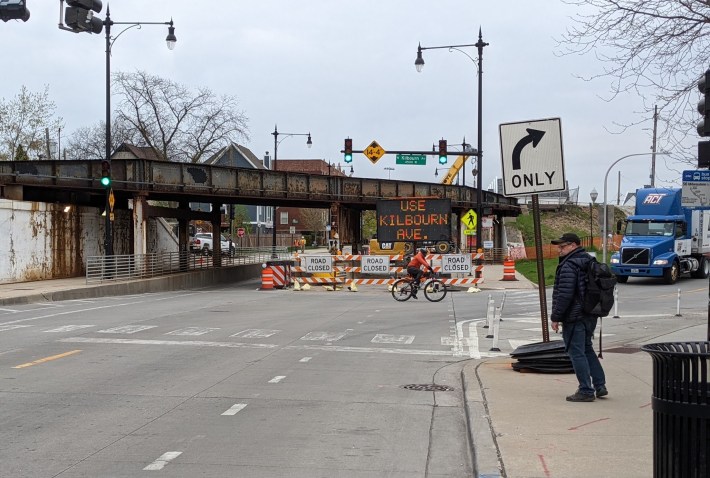Update 5/9/22, 10:15 AM: At a court hearing on Saturday, prosecutors said hit-and-run driver Phil Pinkawa turned himself in after his mother saw a TV report about the crash and "put two and two together," according to a Chicago Tribune report. Pinkawa had left his job as a cook at a pizzeria before he killed Nick Parlingayan. Pinkawa, who also works as a trucker, is being held on $50K bail.
Update 5/6/22, 8:30 PM: The Chicago Police Department announced that Phil Pinkawa, 57, was identified as the driver who fatally struck Nick Parlingayan. Pinkawa was taken into custody and charged with one felony count of failure to report a crash resulting in a death.
When a driver fatally strikes a person on a bike, the least we as a society can do for the victim's loved ones is make policy and infrastructure changes to help ensure that a similar tragedy doesn't happen at that location in the future. Sadly, that's not what happened at the intersection of Milwaukee and Kilbourn avenues in Chicago's Irving Park neighborhood, where drivers have now struck and killed two bike riders. The latest victim was barista Nick Parlingayan, 22, fatally struck last night by a driver who fled the scene.
The Carla Aiello case
Three and a half years earlier, in the morning of November 6, 2019, school counselor Carla Aiello, 37, was riding southeast in the Milwaukee bike lane when a dump truck driver made a right turn in her path, crushing her to death. That night staff from the bikeway advocacy website Bike Lane Uprising led a “human protected bike lane” protest at the site to draw attention to the need for safer conditions for cyclists.
The Chicago Department of Transportation eventually made minor safety improvements to the intersection. These included creating a sidewalk extension with paint and flexible plastic posts at the corner where Aiello was struck, to encourage motorists to slow down while making the turn.

The Nick Parlingayan case
Last night, May 4, at about 9:30 p.m., Nick Parlingayan was biking in the 3800 block of North Milwaukee, according to a statement from the Chicago Police Department. The driver of a black Nissan Versa sedan struck him in the road and fled northwest on Milwaukee.
Parlingayan was transported to Illinois Masonic Hospital in critical condition where he was pronounced dead at 10:10 p.m., according to the Cook County medical examiner's office. He lived about half a mile southeast of the crash site.
Photos of the crash site posted on Twitter indicate that the collision took place about 100 feet northwest of Milwaukee/Kilbourn, in the northwest-bound lanes. (Content warning: One of the images below shows blood on the road.)
Here's some footage from the scene today at Milwaukee & Kilbourn showing cars taking the corner fast & driving in the oncoming lane so the bumpout doesn't slow them down. You can also see the speed of the northbound traffic thru the narrow lane. #bikechi pic.twitter.com/ES4iRyhnbG
— @madopal@mstdn.social (@chownlife) May 5, 2022
Crash site neighbor Kim told ABC, "People blow through this light over here all the time," indicating the stoplight at Kilbourn, where Metra's Milwaukee District North line tracks, which run just east of Kilbourn, cross over Milwaukee Avenue. "And there's a problem. They speed down this road. It's tragic... Something has to be done."
Southeast-bound Milwaukee is currently closed under the Metra viaduct for a construction project. Jersey barriers currently narrow the northwest-bound portion of the road through the underpass, so that motorists are driving in the striped bike lanes, as shown in the image below.

On this stretch of Milwaukee, the northwest-bound bikeway, where Parlingayan was struck, is a buffered bike lane to the left of the curbside parking lane. The southeast-bound bike lane is located next to the curb and is delineated with plastic poles.
Responses from the advocacy community
"This tragic and preventable crash is just the latest example of how Chicago officials are failing to protect people biking on city streets," said Active Transportation Alliance spokesperson Kyle Whitehead. "Milwaukee Avenue has been identified as a major bike corridor in every bike plan the city puts out, yet less than 15 percent of it features protected bike lanes. If Milwaukee Avenue is mostly unsafe and uncomfortable for people on bikes, what hope is there for every other major corridor in the city?"
"There’s been years of outrage and organizing around this specific location, most recently after the tragic death of Carla Aiello in 2019," Whitehead noted. "But the improvements made to date have all been half-measures that fail to address the inherently dangerous design of the roadway that enables cars to travel too quickly and too closely to vulnerable people on bikes. These conditions create conflicts and crashes that can quickly turn deadly, as we’ve seen too many times."
Whitehead added that plenty of funding is currently available for bikeways thanks to federal, state, and local infrastructure programs. "What Chicago is lacking is political will and courage to prioritize safety above the perceived comfort and convenience of people driving. It’s outrageous." He said ATA is reaching out to CDOT and 45th Ward aldermen James Gardiner (who was investigated by the FBI last fall for alleged corruption), to ask what immediate steps will be taken to address the dangerous conditions on this part of Milwaukee.

Bike attorney Brendan Kevenides from FK Law (a Streetsblog Chicago sponsor) noted that the southeast-bound bike lanes of this segment of Milwaukee only have flimsy posts to keep drivers out of them, while the northwest-bound lanes have no physical protection at all. "This is yet another example of why the city should create bicycle lanes with real, hardened protection, like concrete. This is the third cyclist’s death this year and the nice weather hasn’t even started yet. This is unacceptable."
"Compounding this tragedy is that the fatal crash happened in the same location on Milwaukee Avenue where another cyclist was previously killed," said attorney Michael Keating from the bike-focused firm Keating Law Offices (also an SBC sponsor.) "This is not a coincidence. Milwaukee Avenue is simply too narrow to accommodate the number of parked cars and motor vehicles on the road along with cyclists and mass transit. The city of Chicago and its department of transportation need to give serious consideration to eliminating personal motor vehicles from certain sections of Milwaukee."

When no little or no action is taken after a bike fatality, the tragedy is made worse
Milwaukee/Kilbourn is not the only Chicago intersection that been the site of two different bike fatality cases. The complex intersection of Logan Boulevard and Western Avenue in Logan Square saw the death of videographer Tyler Fabeck, 22, in 2008, followed by the killing “School of Rock” drummer Kevin Clark, 32, on May 26 of last year. Advocacy by the victims loved ones and an outcry from the local cycling community led to the city finally implementing a road diet with bike lanes delineated with flexible posts near the intersection last fall.
Hopefully the sadness and outrage over this latest avoidable tragedy in the Irving Park community will lead to major infrastructure changes as well. When transportation officials respond to the first cycling fatality at an intersection with half-measures, or no action at all, leading to a second preventable death, surely it makes the loss harder for the loved ones of both the victims.

Special thanks to Joe Sislow, who serves as Northwest Side representative for the (dormant) Mayor's Bicycle Advisory Council for visiting the crash site today to take photos.
Fatality Tracker: 2022 Chicago pedestrian and bicyclist deaths on surface streets
Pedestrian: 5
Bicyclist: 3
Note: Streetsblog Chicago’s traffic death numbers represent fatal crashes on Chicago surface streets, based on media reports and/or preliminary Chicago Police Department data released by the Chicago Department of Transportation.






